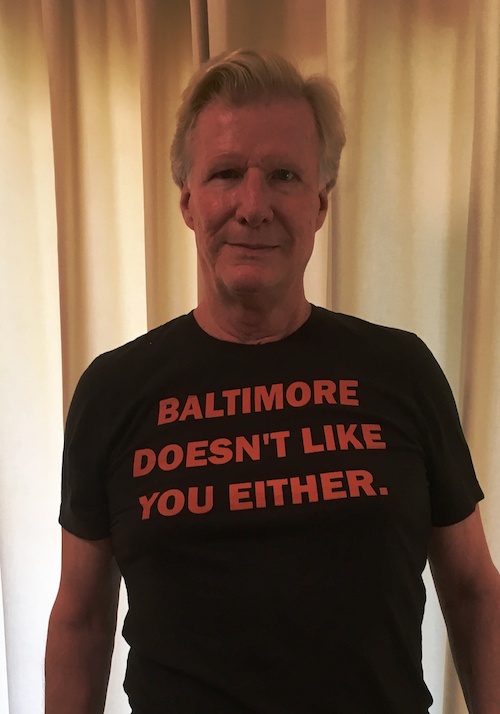Last month, RA Cramblitt released Like Printing Money, a technological crime novel set in Baltimore. It follows his debut novel Probably Lives in Tahiti, described as a rock ’n roll romance, the latter has earned a 4.8-star rating on Goodreads and Amazon.
Cramblitt uses the fast-paced crime plot of Like Printing Money as the engine for an exploration of the shifting culture of Baltimore, the vagaries of greed and friendship, the double-edged sword of technology, the internecine battles within corporate culture, and the strain of relationships under pressure.
We decided to invite the author over to Crime Fiction Lover to ask him about his influences and approach to writing Like Printing Money.
What do you think crime fiction lovers will love about Like Printing Money?
I’m hoping they’ll love finely drawn characters placed in situations that make them behave in unexpected ways, upending readers’ assumptions… a fast-paced, twisting plot tethered to existing technology with a slight futuristic bent… a light-hearted tone despite dire circumstances… the rich backdrop of Baltimore, a city that one character says, “…makes for misshapen dreams and handy scapegoats.”

Like Printing Money is very different from your previous novel, Probably Lives in Tahiti. Was it hard to switch genres?
I’d always wanted to write a crime novel, but I had to do a lot of work to get there. My first book, a collection of vignettes called The Parker Chronicles, taught me how to develop characters that felt like real people, only a bit more interesting and observant than most of us. The book didn’t have a plot, but readers gained an affinity for the characters as each vignette added something to the overall portrait.
Probably Lives in Tahiti had a loose plot that was made up as I went along. It seems odd when you’re the writer, but sometimes the characters you define seem to take control of the narrative. I don’t do a strict outline of plot before writing. I know roughly where I’m going, but as the characters develop I want to be able to veer from the script if a character speaks to me in a different way. The crime novel requires a certain level of discipline. You can’t meander too much – the story has to have momentum and build suspense to propel the reader along. We all want a page turner.
Your characters are quite different from you. How did you choose your characters and develop their back stories?
The characters seem to reveal themselves to me as I go along. They all have characteristics of people I’ve known, but none of them is modeled on a real person. They all face dilemmas. The protagonist is Charlaine Pennington, a statuesque PI who knows she’s good at her job but not so sure she’s doing right by her partner. The malaprop-spouting head of the PI agency thinks his suspicious nature is damaging his home life. The former basketball star turned venture capitalist faces threats to his personal and professional security. A hit man lets his previously subsumed ego get the best of him. A pair of kidnappers have big dreams but much smaller minds. A couple of engineers might not realise how good they have it. And the straw that stirs the drink, a placid, but deadly mystery man, is like a shark looking for its next meal.

You’ve lived in North Carolina for decades. Why did you set your novel in Baltimore?
You can leave Baltimore, but it never leaves you. People from Baltimore are like one big family, sometimes a dysfunctional one. We can often be identified just by saying “Bawlmer” or pronouncing “water” as “wooder.” You meet a Baltimore native or expat on a plane or at the bar and immediately you’re talking about the O’s, the Ravens, who makes the best crab cakes, the TV series Homicide and The Wire. We are ardent defenders of the city. We can talk trash about it, but you can’t if you’re not from there. There’s a t-shirt from a Baltimore artist, Arvay Adams, that reads “Baltimore Doesn’t Like You Either.” That sums it up for many of us.
Technology plays a key role in this book. How did you decide to centre the plot around 3D printing?
I had a career as a technology writer before I turned to fiction. One of the areas I wrote about was 3D printing or additive manufacturing as it is sometimes called. During the course of that work, I got to know a lot about the technology and its manufacturing applications. The positive aspects of 3D printing far outweigh any drawbacks, but just like any relatively new technology, there are fears attached to it. I thought it was an interesting area around which to build a plot.
There’s some grim stuff in the book – and some despicable characters – but there’s also a light and humorous tone that crops up throughout. Why was that important to you?
It just seems to be my style. I’ve always admired writers who combine humor and lightness with drama. To me, that’s life itself. When in dire situations, many of us laugh to maintain sanity and temporarily seal ourselves off from otherwise stultifying pain or stress.
Most authors are avid readers. Who are the crime novel authors that influenced you?
At an early age, it was Arthur Conan Doyle, of course. Then the usual suspects as I got older: Dashiell Hammett, James Cain, Jim Thompson, Patricia Highsmith, Ruth Rendell, Charles Willeford. Elmore Leonard hooked me from the beginning and never let me go. I love novelists who make a specific location a central character in their work: Laura Lippman, KC Constantine, James Lee Burke, Loren Estleman, Michael Connelly, Attica Locke, Archer Mayor and especially George Pelecanos. The specificity of time and place in the early Pelecanos books floored me – his characters were listening to what I listened to and playing basketball on the inner city courts like I was. He was in DC, I was in Baltimore, but the experiences were very similar. It made me think that perhaps I could do this.
Many of the most popular crime and or detective novels have created popular series such as Lee Child’s Jack Reacher, Michael Connelly’s Harry Bosch, Jeffrey Deaver’s Lincoln Rhyme, John Sandford’s Lucas Davenport, James Patterson’s Alex Cross, etc. Do you see that possibility with Charlaine Pennington?
It’s common wisdom that the series is the only way to build a readership. I’ve left open the possibility of future stories featuring Charlaine and/or revisiting a couple of other characters in Like Printing Money. If there are enough readers demanding more Charlaine Pennington, I doubt that I could resist the urge to give them more.
You can find out more about RA Cramblitt on his website, or order a copy of Like Printing Money using the buttons below.
